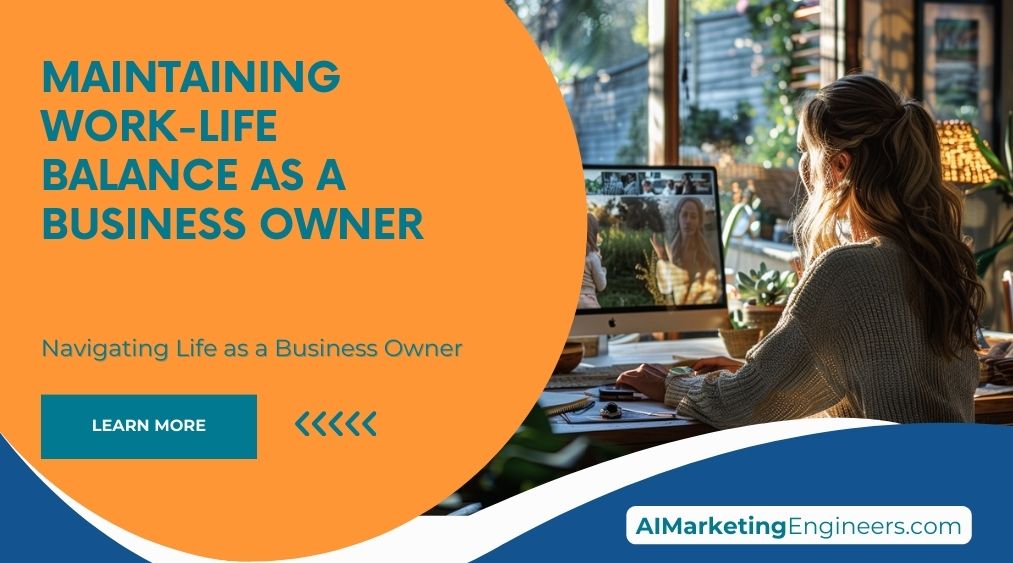Key Takeaways
✅ Prioritize Self-Care and Schedule Time for Fun: It's not just about working smarter; it's about living better. Statistics show that entrepreneurs who engage in regular leisure activities report lower stress levels and higher productivity. From setting aside time for hobbies to ensuring vacations are taken, self-care is the fuel that keeps the engine running smoothly.
✅ Set Boundaries and Learn to Say 'No': Boundaries are the foundation of a healthy work-life balance. A survey reveals that 78% of successful entrepreneurs attribute their well-being to strict personal and professional boundaries, including the art of saying 'no.' Establishing these limits protects your time, energy, and focus, making you more efficient in the long run.
✅ Structure Your Time Effectively: Time management isn't just about fitting more into your day; it's about allocating your most precious resource wisely. With 65% of business owners admitting to working longer hours than the average employee, structuring your time to include work, personal life, and self-care is essential. Effective scheduling leads to a more balanced life and heightened productivity.
 Introduction
Introduction
Have you ever wondered how some business owners seem to have it all under control—the thriving business, the active personal life, and that elusive glow of someone living their best life? Maintaining work-life balance as a business owner is that secret ingredient, a critical aspect ensuring not only the health of your business but your personal well-being too.
In a world where the lines between work and life blur more each day, striking a balance is more challenging—and more important—than ever. Research shows that entrepreneurs who manage this balance well experience less stress and burnout, and report higher levels of happiness and success in their endeavors. But how do they do it? What makes them succeed where so many feel stretched too thin?
This article delves into the heart of this balancing act, offering actionable insights and groundbreaking information to transform your approach to work and life. You’ll learn not just to survive the entrepreneurial journey, but to thrive, enjoying every step. Join us as we unpack strategies, backed by research and real-world success stories, that promise not just growth for your business, but personal fulfillment as well.
Top Statistics
| Statistic | Insight |
|---|---|
| 72% of workers view work-life balance as a vital factor when choosing a job. | This statistic highlights the growing importance of work-life balance not just for employees but also sets a standard for business owners in managing their own. |
| 51% of small business owners say work-life balance has been essential to their success. | This provides an interesting insight into how crucial balancing personal time and work is, proving that success isn't just about long hours but also about smart, balanced living. |
| 33% of small business owners work more than 50 hours a week, and 25% work more than 60 hours a week. | The long working hours indicate a significant challenge in achieving work-life balance, emphasizing the need for efficient time management and delegation among small business owners. |
| 69.3% often answer business-related emails, calls, and texts outside business hours. | This statistic sheds light on the difficulty of disconnecting from work, which is crucial for mental health and overall well-being. |
| 57% of small business owners take vacations, but even then, 67% check in to work at least once a day. | The challenge here is not only in taking a vacation but in the ability to truly unplug, highlighting a significant area for improvement in achieving a healthy work-life balance. |
Setting Boundaries for Entrepreneurs
In the hustle of entrepreneurship, the line between your work and your personal life can easily blur. It's crucial to establish clear boundaries to keep the two separate. This might mean setting firm working hours and sticking to them, or creating a dedicated workspace that's distinct from your living areas. But it's not just about physical spaces; mentally disconnecting from work is equally important. This separation helps ensure that your downtime is truly yours, allowing you to recharge. Communicating these limits to those around you—be it clients, colleagues, or family—helps manage expectations and supports a healthier balance. Have you set your own boundaries yet?
The Art of Delegation and Prioritization
One of the smartest moves an entrepreneur can make is learning when and how to delegate. It's about prioritizing tasks and understanding that you don't have to do everything yourself. Identifying tasks that can be outsourced or handed off is a key step in freeing up your time for activities that require your unique skills and personal attention. Whether it's hiring an assistant, a freelancer, or learning to comfortably say "no" to too many commitments, effective delegation can significantly improve your work-life balance. How comfortable are you in handing off tasks to others?
Mastering Time Management and Self-Care
Time management isn't just about getting more work done; it's also about making sure you have time for yourself. Techniques like the Pomodoro Technique or the Eisenhower Matrix can help optimize productivity, but it's crucial to balance this with self-care. Allocating time for exercise, mindfulness, or hobbies is not indulgence—it's necessary for maintaining your mental and physical well-being. Remember, taking time out for relaxation and leisure isn't a luxury; it's a vital part of keeping yourself fit to run your business. Are you integrating self-care into your daily routine?
Building Support Systems for Sustainable Entrepreneurship
No entrepreneur is an island. Building a support network of peers, family, and friends is crucial for navigating the challenges of owning a business while maintaining a healthy personal life. Mastermind groups and networking communities offer invaluable spaces to connect with others who understand the demands of entrepreneurship. Similarly, investing time in relationships outside of work is essential for a balanced life. Considering a business coach or mentor can also provide guidance and an external perspective on managing the equilibrium between your professional and personal worlds. Who's in your support network?
Maintaining a balance between work and life is a continuous process, not a one-time adjustment. Start small, evaluate what works best for you, and adjust as necessary. Your business, your health, and your personal life will all benefit from the effort to keep them in harmony.
AI Marketing Engineers Recommendation
Recommendation 1: Implement structured digital detox periods: In an age where technology is constantly at our fingertips, Maintaining Work-Life Balance as a Business Owner is more challenging than ever. Recent data suggests that 58% of business owners report frequently feeling overwhelmed by their workload, partly due to the relentless digital demands. By establishing scheduled times for digital detox—periods when you deliberately abstain from all digital devices—you give yourself a chance to decompress, leading to increased productivity and a better work-life balance when you do engage with your work.
Recommendation 2: Prioritize tasks using the Eisenhower Box technique: Embracing effective time management practices is crucial for Maintaining Work-Life Balance as a Business Owner. The Eisenhower Box, a simple yet powerful tool for prioritizing tasks, helps distinguish between what’s urgent and important. It divides tasks into four categories: Do, Decide, Delegate, and Delete. With approximately 47% of workdays lost to managing tasks that don’t directly contribute to business growth, employing this technique can significantly reduce wasted time, enabling business owners to focus more on personal rejuvenation and less on non-essential tasks.
Recommendation 3: Leverage wellness and productivity apps: In today’s digital era, various apps can help in Maintaining Work-Life Balance as a Business Owner. From mindfulness apps like Headspace, which boasts an array of benefits including stress reduction and improved focus, to productivity tools like Asana for task management—these digital solutions empower business owners to stay organized and mentally healthy. With 73% of entrepreneurs reporting that technology has helped them achieve a healthier work-life balance, integrating these apps into daily routines is a practical step towards creating a sustainable business while also caring for personal well-being.
Relevant Links
- Elevate Your Digital Impact with Advanced AI Marketing
- Unlock Secrets to Market Penetration: Master Campaign Reach and Audience Size
- Enhance Marketing Messaging with Ad Personalization
- Harnessing the Power of ROI: Techniques for Maximizing Revenue and Profit
- Optimize Online Sales with Effective E-Commerce Marketing Strategies
Conclusion
In the whirlwind journey of entrepreneurship, maintaining a work-life balance stands out not merely as good advice but as a cornerstone for both personal well-being and business success. This article has journeyed through the critical paths of setting boundaries, the art of task prioritization and delegation, the discipline of time management, and the nurturing of support systems to anchor the importance of equilibrium in an entrepreneur's life. The insights gleaned underscore a fundamental truth: the most successful business owners are those who manage to carve out time for themselves, understanding that taking care of their personal needs fosters productivity and creativity in their professional endeavors.
In light of the discussions, it’s clear that the struggle to maintain a healthy balance is real but not insurmountable. The key takeaway here is the role of proactive strategies—like boundary setting and intelligent delegation—in creating a structured yet flexible environment that accommodates the demands of both work and personal life. Moreover, embracing self-care routines and building robust networks not only enriches an entrepreneur's life but also empowers them to handle the rollercoaster ride of business ownership with resilience and grace.
So, what's your next step in securing a healthier work-life balance? Whether it's refining your time management techniques, joining a community of like-minded entrepreneurs, or simply taking a step back to reassess your priorities, remember that each small change is a significant stride towards not just a more successful business, but a fuller, more satisfying life. Let this be your nudge to not just chase success, but to redefine it on your own terms, ensuring that you thrive both as a business owner and an individual.
FAQs
Question 1: What does work-life balance mean to you?
Answer: Work-life balance means finding a harmonious balance between one's professional and personal life, ensuring that both aspects are fulfilled without compromising the other.
Question 2: How important do you consider work-life balance?
Answer: Work-life balance is crucial as it directly impacts an individual's overall well-being, productivity, and job satisfaction. It is essential for maintaining a healthy and sustainable lifestyle.
Question 3: What strategies do you use to maintain a work-life balance?
Answer: Strategies include setting clear boundaries, prioritizing tasks, managing time effectively, and engaging in activities that promote relaxation and rejuvenation.
Question 4: How do you prioritize tasks to maintain a work-life balance?
Answer: Prioritize tasks based on their urgency and importance. Focus on completing critical tasks during work hours and delegate or defer less important tasks when possible.
Question 5: How do you handle work-related tasks outside of work hours?
Answer: Establish clear boundaries by setting specific times for checking work emails or taking work calls. Avoid overcommitting and learn to say "no" when necessary.
Question 6: How do you manage stress and burnout?
Answer: Identify stressors, take regular breaks, practice self-care, and engage in activities that bring joy and relaxation. Recognize the signs of burnout and take proactive steps to prevent it.
Question 7: How do you ensure a healthy work culture?
Answer: Foster open communication, provide support and resources, and encourage employees to maintain a work-life balance. Lead by example and prioritize employee well-being.
Question 8: What benefits do you offer to support work-life balance?
Answer: Offer flexible work arrangements, paid time off, and wellness programs. Provide resources for managing work-life balance and support employees in achieving their personal goals.
Question 9: How do you measure the success of work-life balance initiatives?
Answer: Monitor employee satisfaction, productivity, and retention rates. Conduct regular surveys and feedback sessions to assess the effectiveness of work-life balance initiatives.
Academic References
- Clark, S. C. (2000). "Work/family border theory: A new theory of work/family balance." Human Relations, 53(6), 747-770. This article introduces the concept of boundary work, emphasizing its significance in crafting, deconstructing, and maintaining the border between work and home, which is essential for achieving work-life balances.
- Greenhaus, J.H., & Allen, T.D. (2011). "Work-family balance: A review and extension of the literature." Handbook of Occupational Health Psychology, (pp. 165-183). This research sheds light on the importance of recognizing the variety of nonwork domains—education, health, leisure, friendships, romantic relationships, family, household management, and community involvement—and their varied significance and impact on individual's work-life balance.
- Hill, E.J., Grzywacz, J.G., Allen, S., Blanchard, V.L., Matz-Costa, C., Shulkin, S., & Pitt-Catsouphes, M. (2008). "Defining and conceptualizing workplace flexibility." Community, Work & Family, 11(2), 149-163. This study underlines the crucial need for firms to enhance the online visibility of their work-life practices to attract younger talent who prioritize flexibility and a harmonious work-life balance.
- Kossek, E.E., & Lautsch, B.A. (2012). "Work-life flexibility for whom? Occupational status and work-life inequality in upper, middle, and lower level jobs." Academy of Management Annals, 6(1), 103-141. Highlighting work-life balance as an ongoing cycle, this article emphasizes the necessity for continuous self-evaluation and adjustment in one's work and personal life to maintain balance.












